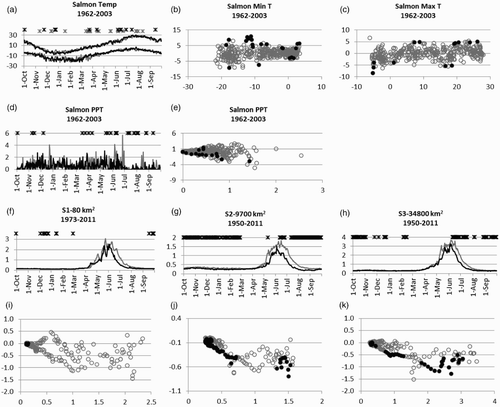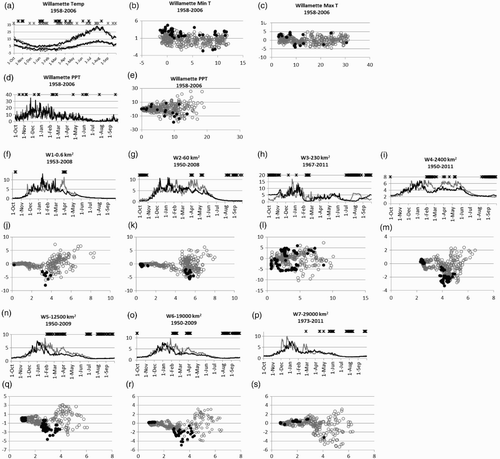Abstract
Large river basins transfer the water signal from the atmosphere to the ocean. Climate change is widely expected to alter streamflow and potentially disrupt water management systems. We tested the ecological resilience—capacity of headwater ecosystems to sustain streamflow under climate change—and the engineering resilience—capacity of dam and reservoir management to overprint a climate change signal—in seven sub-basins of the Columbia River from 1950 to 2011. Sub-basins had a headwater gauge above dams with a long-term streamflow record and a nearby climate station with a long-term record of air temperature and precipitation, as well as matching long-term streamflow records at gauges downstream of dams. Trends were fitted to daily data for maximum and minimum temperature, precipitation, and streamflow over the period of record (mostly 1950–2011). Consistent with predicted streamflow response to climate warming, annual snowmelt runoff peaks in five of seven headwater basins shifted to a few days earlier over the period 1950 to 2010, but the changes were small, displaying ecological resilience. Below dams, streamflow change was attributable to reservoir operation for flood control (reduced annual peak flows) and irrigation (augmented late summer low flows), as well as flow management for hydropower, navigation, and recreation, but predicted streamflow responses to climate change were absent, indicating engineering resilience. Thus, to date, climate-warming effects on streamflow have been limited to headwaters, and flow regulation has obscured the expression of climate change on streamflow below dams in the Columbia River basin.
RÉSUMÉ [Traduit par la rédaction] Les grands bassins fluviaux transfèrent le signal d'eau de l'atmosphère à l'océan. De manière générale, on s'attend à ce que le changement climatique modifie l’écoulement fluvial et possiblement perturbe les systèmes de gestion d'eau. Nous avons étudié la résilience écologique — la capacité des écosystèmes des cours supérieurs des rivières de maintenir l’écoulement fluvial dans le contexte d'un changement climatique — et la résilience des ouvrages hydrauliques — la capacité de la gestion des barrages et des réservoirs à compenser un signal de changement climatique — dans sept sous-bassins du fleuve Columbia de 1950 à 2011. Les sous-bassins avaient une jauge de niveau en amont des barrages avec des enregistrements d’écoulement à long terme, une station climatologique à proximité avec des enregistrements de température et de précipitations à long terme ainsi que, en aval des barrages, des enregistrements à long terme correspondants d’écoulement à des jauges de niveau. Les tendances ont été ajustées en fonction des données quotidiennes de températures maximale et minimale, de précipitations et d’écoulement fluvial pour la période des enregistrements (principalement 1950–2011). Conformément à la réponse prévue de l’écoulement fluvial au réchauffement climatique, les pointes annuelles de ruissellement d'eau de fonte dans cinq des sept bassins supérieurs se sont déplacées quelques jours plus tôt au cours de la période 1950–2010, mais les changements étaient petits, ce qui témoigne d'une résilience écologique. En aval des barrages, le changement d’écoulement fluvial était attribuable à l'utilisation des réservoirs pour la protection contre les crues (débits de pointe annuels réduits) et l'irrigation (débits d’étiage de fin d’été augmentés) de même qu’à la gestion de l’écoulement pour les besoins de l’énergie hydroélectrique, de la navigation et des activités récréatives, mais les réponses prévues des écoulements fluviaux au changement climatique étaient absentes, ce qui indique une résilience des ouvrages hydrauliques. Donc, jusqu’à maintenant, les effets du réchauffement climatique sur l’écoulement fluvial se sont limités aux cours supérieurs des rivières et la gestion de l’écoulement a masqué l'empreinte du changement climatique sur l’écoulement fluvial en aval des barrages dans le bassin du fleuve Columbia.
1 Introduction
Climate change is widely expected to alter streamflow and potentially disrupt water management systems. Increased temperature throughout the region (Littell et al., Citation2011) is associated with declining snow water equivalent in much of the Pacific Northwest (Hamlet, Mote, Clark, & Lettenmaier, Citation2005; Knowles, Dettinger, & Cayan, Citation2006; Mote, Citation2003). Warming and earlier snowmelt are associated with earlier onset of snowmelt runoff in spring (Cayan, Kammerdiener, Dettinger, Caprio, & Peterson, Citation2001; Nayak, Marks, Chandler, & Seyfried, Citation2010; Stewart, Cayan, & Dettinger, Citation2005), which in turn is expected to reduce late summer streamflow (Barnett et al., Citation2008; Mote et al., Citation2003), increasing streamflow variability (Karl, Melillo, & Peterson, Citation2009). Hydrologic models indicate that climate change has altered snowmelt timing and intensified late summer drought in the Pacific Northwest (Hamlet et al., Citation2005; Hamlet & Lettenmaier, Citation2007; Lutz, Hamlet, & Littell, Citation2012), and trends in monthly flow from 1958 to 2008 for 68 streams in the Pacific Northwest are consistent with these predictions (Chang, Jung, Steele, & Gannett, Citation2012). Since 1948, streamflow in low flow years has declined significantly in the Pacific Northwest (Luce & Holden, Citation2009), and the centre of timing of river flows shifted earlier over the period 1950 to 2000 in the Columbia River basin (Barnett et al., Citation2008). Climate change models predict continued warming with little change in precipitation in the Pacific Northwest (Lutz et al., Citation2012; Mote & Salathé, Citation2010). These observed and anticipated future trends suggest that water managers may face intensified conflicts among alternative water uses, especially in late summer.
However, two important sets of processes may mitigate these effects on water availability induced by climate change. Headwater ecosystems in the Columbia River basin are dominated by conifer forests which are adapted to summer drought and capable of reducing transpiration in response to elevated temperature. Conifers may also exploit earlier snowmelt to initiate transpiration and photosynthesis earlier in the year. These mechanisms may confer ecological resilience to climate change in headwater basins, which we define as the capacity of headwater ecosystems to sustain amount, timing, and variability of streamflow despite climate warming. This definition follows Holling (Citation1973), who defined resilience as the amount of disturbance a system can absorb and still remain in the same state. Holling (Citation1996) included persistence, change, and unpredictability in his concept of ecological resilience; Folke (Citation2003) emphasized that the complete hydrologic cycle in headwaters is fundamental to ecosystem resilience.
Since 1900 more than 2,000 dams have been constructed in the Pacific Northwest, and reservoir operations for flood control, irrigation, recreation, hydropower, and other benefits have significantly altered streamflow signals throughout most of the network. Dam construction in the United States in the last century produced a nearly linear increase in the cumulative volume of reservoir storage capacity to its present level, equivalent to 35% of the mean annual flow in the Pacific Northwest region (Graf, Citation1999, Citation2006). Reservoir operations designed to diminish winter or spring peak flows may counteract or obscure a climate-induced shift to earlier streamflow, and reservoir operations to store and release water for late summer low flow augmentation would tend to have the opposite effect of climate-induced hydrologic drought. In large river basins such as the Columbia River, these mechanisms may confer engineering resilience to climate change, which we define as the capacity of engineered water management system operations to mitigate or overwhelm trends in streamflow induced by climate change. This definition follows Holling (Citation1996), who characterized engineering resilience as focusing on efficiency, constancy, and predictability.
This study seeks evidence for the ecological and engineering resilience of streamflow in the Columbia River basin using observational records since 1950. Given the climate-warming signal (and earlier snowmelt) in headwaters, we would expect to see earlier snowmelt-related hydrograph peaks (spring snowmelt peaks) and possibly reduced late summer flow in headwater ecosystems (). However, if this signal does not appear in headwaters, in spite of climate warming, it may indicate ecological resilience. If streamflow in the headwaters responds as expected to climate warming, this signal would be expected to propagate downstream (). However, if headwater streamflow response to climate change is not observed downstream it may indicate engineering resilience.
Fig. 1 This study examined seven principal tributary basins within the Columbia River system above Portland, Oregon. For each tributary basin, a paired climate and streamflow record was identified in the headwaters of the basin, and a series of gauges was identified downstream from that headwaters. The study asked two questions. (1) How has streamflow changed in headwater basins, given the climate change signal imposed locally? (2) How do the changes in streamflow in the headwater basin compare to those downstream of dams (indicated by triangles)?

2 Study sites
Seven principal sub-basins of the Columbia River were examined, ranging in size from 2,300 km2 to 240,000 km2 (): Willamette River (b), Entiat River (c), Priest River (d), Bruneau River (e), Pend Oreille River (f), Salmon River (g), and Snake River (h), as well as the mainstem Columbia River. Sub-basins were selected to span varying hydrologic regimes (rain-dominated vs. snow-dominated). Study basins were selected if they had an upstream gauge above dams with a long-term streamflow record (ideally, 1950–2011), a nearby climate station with a long-term record of air temperature and precipitation, as well as downstream gauges with long-term streamflow records, downstream of dams managed for irrigation, flood control, hydropower, and/or recreation. Data in headwaters above dams were severely limited, and sub-basins may not be representative of larger areas. Although they are unregulated, headwater basins may have been disturbed by logging, wildfire, mining, or land-use conversion; only W1 () is a true “reference” watershed.
Fig. 2 Columbia River basin, showing locations of climate stations, stream gauges, and dams in the seven sub-basins examined in this study (a) overview of Columbia River basin showing seven sub-basins, (b) Willamette River (W), (c) Entiat River (E), (d) Priest River (P), (e) Bruneau River (B), (f) Pend Oreille River (O), (g) Salmon River (S), and (h) Snake River (S). Codes are one-letter basin abbreviation and number of gauge, from headwaters to downstream.
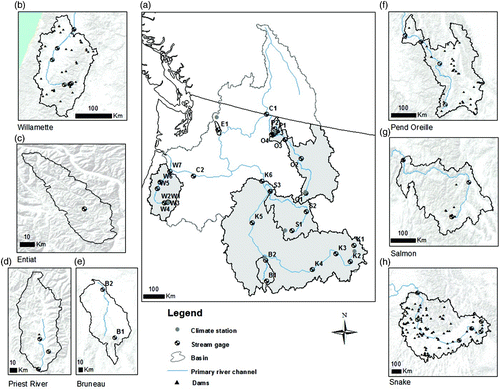
The study sub-basins represent 61% of the drainage area of the Columbia River above The Dalles, which is 613,800 km2. The western sub-basin (dominated by the Willamette River) covers only 7% of the total basin area of the Columbia River but contributes 25% of the total flow at the mouth, and this runoff mostly originates from winter precipitation (November to March). The interior sub-basin produces runoff during spring snowmelt (April to July). The Canadian portion of the interior sub-basin covers only 23% of the drainage area above The Dalles, but contributes 52% of the flow at The Dalles, whereas the Snake River basin covers 43% of the interior sub-basin area but only contributes 28% of the flow at The Dalles (Naik & Jay, Citation2005).
The study sub-basins range from less than 530 km2 (Entiat River) to over 240,000 km2 (Snake River) and span a range of elevations, climate conditions, land uses, and water regulations (). All study sub-basins drain high elevations where precipitation is relatively high. However, the interior sub-basins, especially the Bruneau and Salmon receive less than 10%, and six of the study sub-basins receive less than 40% of the precipitation received in the Willamette sub-basin headwaters. Seasonal snowpacks dominate the upper elevations of all basins. Five of the study sub-basins are predominantly evergreen forest: Priest (86%), Pend Oreille (65%), Entiat (53%), Salmon (53%), and Willamette (50%). Two of the sub-basins are dominated by scrubland: Bruneau (86%) and Snake (49%). The Willamette (8%) and Snake (7%) sub-basins have the greatest amount of cultivated area, and the Willamette (21%), Snake (9%), and Pend Oreille (4%) have the largest amount of irrigated area (pasture and/or hay plus cultivated crops). These three basins also have the highest numbers and densities of dams. Dams in the Willamette are managed for recreation, irrigation, flood control, and hydropower, whereas dams on the Snake and Pend Oreille are predominantly managed for irrigation ().
Table 1. Key characteristics of sub-basins of the Columbia River examined in this study.
3 Methods
In each sub-basin a headwater basin record was identified for an unregulated (but not necessarily undisturbed) basin. A daily climate station record was identified as near as possible to the headwaters basin (grey dots in ); these records exceeded 50 years (). Streamflow records were obtained from the headwater basin and gauges at successive downstream points (, ). Most of these records exceeded 50 years. Of seven headwater basins, four had climate records of 60 years, two had records of 48 years, and one had a record of 41 years (). Of 28 stream gauges, 12 had records longer than 60 years, 10 had records longer than 50 years, one had a record longer than 40 years, three had records longer than 30 years, one had a record longer than 20 years, and one had a record longer than 10 years ().
Table 2. Climate station elevation and record length in headwaters of seven sub-basins of the Columbia River.
Table 3. Basin size and record length for gauges in seven sub-basins of the Columbia River in this study.
Fig. 3 Mean annual flow at gauges from headwaters to downstream in sub-basins in the study (a), and hydrographs and hyetographs from each sub-basin. (b) Bruneau River, (c) Entiat River, (d) Snake River, (e) Pend Oreille River, (f) Priest River, (g) Salmon River, (h) Willamette River. Hyetographs are mean daily precipitation shown on inverted scale. Hydrographs are mean daily flow. See and for station and gauge information.
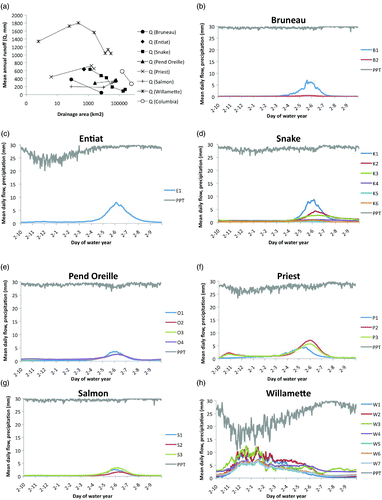
Trends in maximum and minimum temperature (T), precipitation (P), and streamflow (Q) for each day of the year over the period of record were determined using linear regression. Streamflow and precipitation data were log-transformed prior to analysis. Days with zero precipitation were replaced with 0.0001 mm prior to log transformation. Trends were calculated for absolute flow and for relative flow (daily flow as a fraction of annual flow) for each day. A 95% confidence interval was constructed around the regression slope for each day; slopes falling above the confidence interval were considered to be significant positive trends, while slopes falling below the confidence interval were considered to be significant negative trends. Hovmöller plots (Hovmöller, Citation1949) were created for original and log-transformed data and examined to visually discriminate long-term trends from cyclical or short-term patterns. Analyses were conducted in MATLAB.
The 95% confidence interval balances type I errors (accepting a false positive) with type II errors (incorrectly accepting the null hypothesis). For these data, there may be more type I errors because separate linear regressions on each day of the year may not be independent or might be considered multiple comparisons; in both cases this would argue for the use of a smaller confidence interval to protect against type I errors. However, the type II error of a test depends not only on sample size (power) but also on how data transformation affects the change being examined. Log-transformation of precipitation and discharge data effectively magnifies the small values (i.e., low precipitation, low flows) and diminishes the large values (i.e., high precipitation, peak flows), thus increasing the probability of a type II error (failing to detect a change that occurred) for days with high and variable precipitation (or streamflow). Further discussion of type I and type II errors in streamflow statistical analysis can be found in Jones and Grant (Citation1996), Thomas and Megahan (Citation1998), Jones and Grant (Citation2001), and Thomas and Megahan (Citation2001).
For each day of the year, we evaluated statistical significance (p less than some critical value) and practical significance (magnitude of change) of the trend over time (Ramsay & Schaefer, Citation1996). Because of interannual variability, trends in high flows may be “practically significant” even if they were not statistically significant. Conversely, trends in lowflows, which have low interannual variability, may be statistically significant, but their practical significance may be debatable. To test for type II errors, we calculated the difference in mean daily precipitation and temperature (and median streamflow) between the first and last decades of the record. This is a measure of “practical significance” of the change (see grey and black lines in to ). For each day, we plotted this change as a function of the mean (for T, P) or median (Q) value for the entire period of record ( to ). We evaluated whether this difference was statistically significant using the linear regression approach (see grey and black dots, and grey and black x's in to ). Moreover, we evaluated shifts in runoff timing based on the means and medians plots ( to ).
Fig. 4 Changes in daily temperature (T) ((a), (b), and (c)); precipitation (P) ((d), (e)), and streamflow (Q) ((f) to (i)) in the Bruneau River basin. (a), (d), (f), and (g) Daily average (T, P) or median (Q) values for each day of the water year from the first decade of record (grey line) and the last decade of record (black line). Black Xs (for Max T, P, Q) and grey Xs (for Min T) above the line graphs indicate days which experienced significant changes (p < 0.05) based on regression analysis. (b), (c), (e), (h), and (i) Scatter plots of daily average (T, P) or median (Q) values for the entire period of record (x-axis) versus the change from the first decade to the last decade (y-axis). Open grey circles are values for all days (n = 365); closed black circles represent days with significant changes (p < 0.05) based on regression analysis. Units are °C for T, and mm for P and Q. P and Q data were log-transformed prior to linear regression. Both B1 and B2 are upstream of a dam. Basin sizes, and characteristics and names and locations of meteorological stations and gauges are given in to .
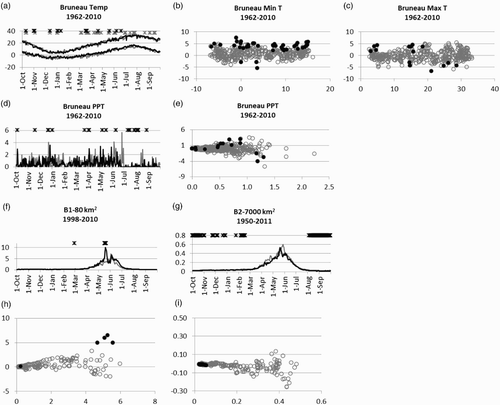
We analyzed trends for each day of the year, rather than using data that had been smoothed or aggregated into coarser time intervals (e.g., months). Smoothing the data with a running mean would introduce (more) autocorrelation in the data. Grouping data by arbitrary units (months) obscures shifts in the timing of streamflow that are less than one month. Results were interpreted by examining groups of multiple days with significant changes to avoid inferring trends on days affected by a recent flood.
We conducted a linear regression of appropriately transformed data rather than the nonparametric Mann-Kendall test recommended for analysis of trends in precipitation and streamflow (Helsel, Mueller, & Slack, Citation2005; Helsel & Hirsch, Citation1992). Linear regression and Mann-Kendall tests produced virtually identical results for 280 datasets of streamflow from headwater basins (Hatcher, Citation2011).
Autocorrelation was tested before and after trend analysis. Each day of data for which a trend analysis was conducted was tested for year-to-year autocorrelation at lags up to ten years. Of the possible 3650 significant autocorrelations in each dataset (365 days × 10 1-day lags), autocorrelation was present in 0 to 12% of the 28 streamflow records tested, with a mean of 2.3%. Residuals of each daily regression were also tested for autocorrelation, which was present in 0 to 6% of the 28 streamflow records, with a mean of 1.8%.
Land-cover types, elevation, and dams were documented for each basin. Watershed boundaries were taken from United States Geological Survey data (USGS, Citation2012a), edited to include only the area upstream of the most downstream stream gauge. Land cover was taken from the 2006 National Land Cover Database, which has 30 m resolution and 16 land-cover classes (USGS, Citation2012b). Elevation was determined from 1 km Global 30 Arc Second (GTOPO30) digital elevation models (DEM) (USGS, Citation2012c). Data on dams were from the Major Dams of the United States dataset created by the National Atlas (US Department of the Interior, Citation2012).
4 Results
Irrespective of basin area, streamflow is highest in the western (Willamette) and lowest in the eastern (Bruneau, Snake, Pend Oreille, Salmon) sub-basins (a). Precipitation is concentrated in the early part of the water year (November–January) at the Entiat, Priest, and Willamette sub-basins but relatively evenly distributed throughout the year at the other sub-basins (b to 3g). Seasonal snowpack accumulation and melt delays peak annual flows to May or June at all sub-basins except the Willamette, where peak annual flows coincide with peak precipitation in December to February. The Columbia River mainstem at the United States–Canada border and the Columbia River at The Dalles have annual peaks in early June.
a Temperature and Precipitation Trends in Sub-Basins
Minimum and/or maximum daily air temperature increased but daily precipitation did not change consistently at climate stations in the headwaters of study sub-basins over the period 1950 to 2010 ( to ). At all seven sites, significant increases in minimum or maximum daily temperature or both were observed on more than ten days. The number of days with significant increases was larger than the number with significant decreases, and the average temperature change was positive ( to ), consistent with much more complete regional studies of climate trends (e.g., Littell et al., Citation2011).
In the Bruneau headwaters, minimum daily temperature increased on 37 days (average change +0.3°C per decade for March to September), and maximum daily air temperature increased on 9 days from 1962 to 2010. Significant changes in precipitation occurred on fewer than 25 days, and average annual precipitation declined from 200 mm to 178 mm (a to 4e). In the headwaters of the Entiat, minimum daily temperature increased on 100 days (average change +0.3°C per decade for April to November), and maximum daily air temperature increased on 38 days from 1950 to 2010. Significant changes in precipitation were seen on only 18 days, and average annual precipitation declined from 941 mm to 867 mm (a to 5e). In the Snake headwaters, minimum daily temperature increased on 10 days (average change +0.5°C per decade for March), and maximum daily air temperature increased on 63 days (average change +0.5°C per decade for March, and 0.4°C for July and August) from 1950 to 2010. Significant changes in precipitation occurred on fewer than 17 days, and average annual precipitation increased from 538 mm to 566 mm (a to 6e).
Fig. 5 Changes in daily temperature (T) ((a), (b), and (c)); precipitation (P) ((d), (e)), and streamflow (Q) ((f), (g)) in the Entiat River basin. (a) to (g) Same as in . There are no dams on the Entiat.
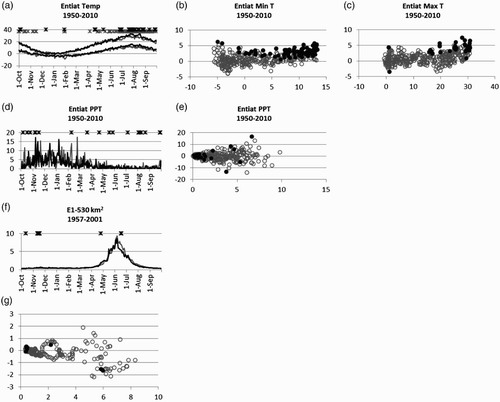
Fig. 6 Changes in daily temperature (T) ((a), (b), and (c)); precipitation (P) ((d), (e)), and streamflow (Q) ((f) to (q)) in the Snake River basin. (a) to (q) Same as in . K1 is upstream of dams; K2 to K6 are downstream.
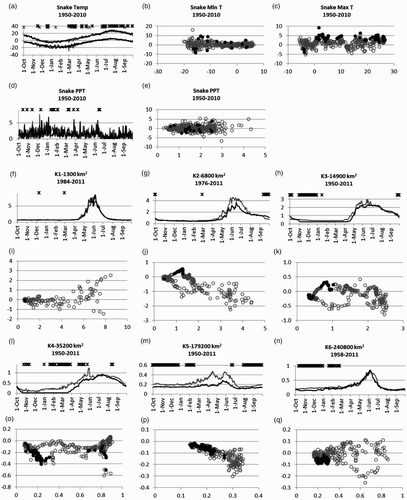
In the headwaters of the Pend Oreille, minimum daily temperature increased on 48 days (average change +0.4°C per decade for March), and maximum daily air temperature increased on 43 days (average change +0.6°C per decade for March and +0.4°C per decade for July through September). Significant changes in precipitation were seen on a total of 15 days, and average annual precipitation declined from 404 mm to 330 mm (a to 7e). In the Priest headwaters, minimum daily air temperature both increased and decreased on 35 days (average change +0.1°C per decade in March through July), and maximum daily air temperature increased on 21 days (average change +0.1°C per decade for March through July) from 1950 to 2010. Significant changes in precipitation occurred on a total of 18 days, and average annual precipitation declined from 875 mm to 778 mm (a to 8e). In the headwaters of the Salmon, minimum daily air temperature increased on 16 days (average change +0.2°C per decade for March through August), and maximum daily air temperature increased on 7 days (average change +0.1°C per decade for March through August) from 1962 to 2003. Significant changes in precipitation occurred on a total of 25 days, and average annual precipitation did not change (a to 9e). In the Willamette headwaters, minimum daily air temperature increased on 46 days (average change +0.4°C per decade in January and +0.2°C per decade in March and April), and maximum daily air temperature increased on 16 days (average change +0.4°C per decade in January and +0.1°C per decade in March and April) from 1958 to 2006. Significant changes in precipitation were seen on a total of 18 days, and average annual precipitation increased from 2237 mm to 2336 mm (a to 10e).
Fig. 7 Changes in daily temperature (T) ((a), (b), and (c)); precipitation (P) ((d), (e)), and streamflow (Q) ((f) to (m)) in the Pend Oreille River basin. (a) to (m) Same as in . All stations are downstream of dams.

Fig. 8 Changes in daily temperature (T) ((a), (b), and (c)); precipitation (P) ((d), (e)), and streamflow (Q ) ((f) to (k)) in the Priest River basin. (a) to (k) Same as in . P1 is upstream of dams; P2 and P3 are downstream of dams.
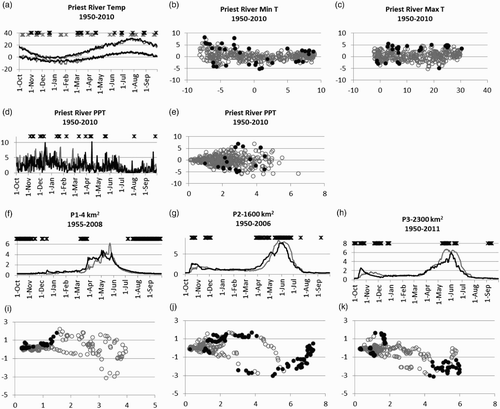
b Streamflow Trends in Headwaters
Headwater streamflow was expected to show a climate change signal, but headwater records from unregulated basins also may have been influenced by wildfire, logging, and mining. Of the seven headwater basins, four experienced no change, two experienced earlier snowmelt runoff, and one (Pend Oreille), which is downstream of irrigated agriculture, showed a regulatory signal ( to , ). In the headwaters of the Bruneau, few daily streamflow changes were observed, but the record only covers 1998 to 2010 (f and 4h). There were few days of streamflow change in the Entiat headwaters from 1957 to 2001 (f and 5g). However, much of the basin area burned in 1970 (Adams, Loughry, & Plaugher, Citation2008; Woodsmith, Vache, McDonnell, Seibert, & Helvey, Citation2007). Forest removal tends to delay snowmelt (e.g., Jones & Post, Citation2004), and visual examination of the Hovmöller plot of Entiat streamflow reveals delayed spring runoff after 1970, potentially counteracting climate-warming effects.
Table 4. Summary of observed evidence of climate change and river regulation signals at the 28 stream gauges in headwater sites and below dams in seven sub-basins of the Columbia River. Sub-basin designations are from . Gauge sites are designated H = headwater or B = below dam or H* = above dams but downstream of irrigated agriculture. Codes “x” and “o” were assigned based on visual evaluation of median/mean values in first, last decade (x), or counts of numbers of days with significant trends from regressions of log-transformed data (o).
In the headwaters of the Snake, there were only two days that showed significant changes from 1984 to 2011 (f to 6i). This basin drains Yellowstone National Park, much of which was lodgepole pine forest burned by severe fires in 1988 and vegetation recovery has been slow (Christensen et al., Citation1989; Turner, Romme, Gardner, & Hargrove, Citation1997); visual inspection of the Hovmöller plot of streamflow reveals no clear response of spring runoff timing after the fires, perhaps because the record began only three years before the fire. The most upstream gauge in the Pend Oreille was downstream of irrigated agriculture and is discussed below.
In the headwaters of the Priest, streamflow increased on 138 days, by 75% in March to mid-April and by 50% in July through mid-November from 1955 to 2008, consistent with a shift from snow to rain and earlier snowmelt runoff (f to 8i). Most of the Priest River headwater basin is undisturbed forest, although small areas have been clear-cut (Adams et al., Citation2008). In the Salmon headwaters, there were 16 days that showed significant declines in streamflow in September and December through March; medians show a non-significant decline in late snowmelt peak runoff (f to 9i). This basin includes the Thompson Creek molybdenum mine and a tailing pond; mining and management of the pond may influence streamflow trends.
In the Willamette headwaters (sub-basin W1), there were 11 days in March and April that showed significant declines; the medians show that spring streamflow declined, and winter streamflow increased (not significantly), consistent with earlier snowmelt runoff (f to 10j). This basin is undisturbed old-growth Douglas-fir forest (Jones & Post, Citation2004). Streamflow at sub-basin W2, which is also above dams, declined by 30% on 58 days in April and May and August through October; decreased April–May streamflow and (non-significant) increases in January streamflow indicate earlier snowmelt runoff (g to 10k). About 25% of this basin was converted to young forest plantations from 1950 to 1970, which may have affected snowmelt timing and late summer water yield (Hicks, Beschta, & Harr, Citation1991; Jones & Grant, Citation1996, Jones & Post, Citation2004, Perry, Citation2007).
c Streamflow Trends at Downstream Gauges
Trends in streamflow at downstream gauges bore little resemblance to trends in the headwaters. Of the 21 sites downstream of dams, 20 experienced a regulation signal, with decreases in winter flows, annual peak flows, and occasional increases in late summer low flows ( to , ). All trends reported below are statistically significant.
Fig. 11 Changes in daily streamflow (Q) (a) to (d) on the Columbia River mainstem. (a), (b) Daily median Q values for each day of the water year from the first decade of record (grey line) and the last decade of record (black line). (c), (d) Scatter plots of daily median Q values for the entire period of record (x-axis) versus the change from the first decade to the last decade (y-axis). Symbols and units are same as in . Both stations are downstream of dams.
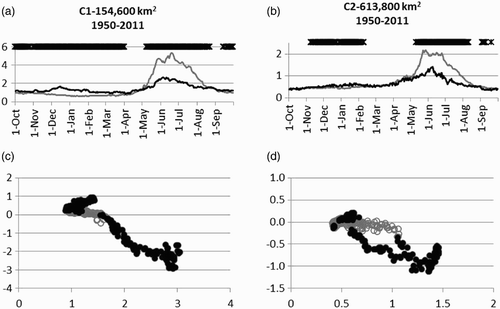
In the Bruneau, streamflow at sub-basin B2 declined on 106 days in August through February (average change −25%) from 1950 to 2011 (g to 4i). In the Snake, five basins downstream of dams experienced a regulatory signal: declining flows in the winter (all basins), declining peak runoff (two basins), and increasing low flows in September (two basins). Streamflow at sub-basin K2 increased by 50% in the second half of September and declined by 30% in May through July over the period 1976 to 2011 (g to 6j). At sub-basin K3, streamflow increased on 15 days in September and October (average change 25%) and decreased on 60 days in November and December (average change −45%) from 1950 to 2011 (h to 6k). At sub-basin K4 streamflow declined by 67% from October through May and 10% in August from 1950 to 2011 (l to 6o). Streamflow at sub-basin K5 declined significantly on 177 days from August to March (average change −25%), and peak runoff declined by 45% in April through June from 1950 to 2011 (m to 6p). At the largest sub-basin (K6), streamflow declined on 106 days from October through February (average change −25%) over the period 1958 to 2011 (n to 6q). Trends were also fitted for the Snake River basins for the common period 1980 to 2011. These analyses produced fewer days with significant trends but a similar overall pattern.
In the Pend Oreille, four basins downstream of dams also experienced a regulatory signal of declining winter flows, declining peak runoff (three basins), and increasing low flows at the end of the water year (two basins). All gauges in the Pend Oreille are downstream of irrigated agriculture (sub-basin O1) or dams. At sub-basin O1, winter streamflow declined on 84 days in October through February (average change −20%), and low flows increased on 44 days in August and September (average change 40%); these increases may be attributable to groundwater pumping (f to 7j). At sub-basin O2, winter and peak streamflow declined significantly on 114 days from October to July; water-year streamflow declined by 20% (i to 7k). At sub-basin O3, winter streamflow and peak streamflow declined significantly on 63 days from October through July; water-year streamflow declined by 20% (h to 7l). At sub-basin O4, winter and peak streamflow declined on 82 days from November through March (average change −25%), and late summer low flows increased on 17 days in October (average change 30%) (i to 7m).
In the Priest, basins downstream of dams experienced both a climate change signal (earlier snowmelt) and a regulatory signal (declining winter flow). From 1950 to 2006, streamflow at sub-basin P2 decreased on 54 days in November to December and May to June (average change −15%) and increased by 60% in April and nearly 90% in late October; medians display an earlier onset of snowmelt runoff, accounting for significant, even if very small, changes in high flows (g to 8j). Streamflow at sub-basin P3 decreased on 62 days in November, December, May, and June (average change −30%) and increased by 90% on 12 days in October from 1950 to 2011 (h to 8k).
In the Salmon, basins downstream of dams experienced a regulatory signal (declining winter flow and declining peak flow) but no low flow augmentation. Streamflow at sub-basin S2 declined on 208 days in June through February (average change −25%) from 1950 to 2011 (g to 9j). At S3, streamflow declined on 96 days, also in June through February (average change −20%) from 1950 to 2011 (h to 9k).
In the Willamette, basins below dams displayed a regulatory signal of declining peak flows and augmented low flows. Streamflow at sub-basin W3 declined on 60 days in February, July, and August (average change −25%) and increased by 125% on 54 days from September through November (average change 125%) from 1967 to 2011 (h to 10l). Trends at sub-basin W3 are consistent with flood regulation and are affected by relocation of stream gauges during the construction of the Blue River dam, completed in 1969. At sub-basin W4, peak streamflow declined on 34 days in February through May (average change −25%), and low flow increased on 42 days from September to mid-October (average change 20%) from 1950 to 2011 (i to 10m). At sub-basin W5, peak streamflow declined on 62 days from February through April (average change −35%), and low flow increased on 42 days in August and September (average change 15%) from 1950 to 2009 (n to 10q). At sub-basin W6 peak streamflow declined on 31 days from February to April (average change −30%), and low flow increased on 52 days from August to September (average change 20%) from 1950 to 2009 (o to 10r). At sub-basin W7, streamflow increased on 36 days in April through June (average change 15%) from 1973 to 2011 (p to 10s). The medians of sub-basins W4, W5, W6, and W7 all show declines in peak flows from the first to the last decade of record.
d Streamflow Trends on the Columbia
In the Columbia River basin at the United States–Canada border (sub-basin C1) peak streamflow declined on 105 days from early May to mid-August (average change −40%) and increased on 192 days from September through April (average change 50%) from 1950 to 2011 (a and 11c). On the mainstem Columbia River downstream at The Dalles (sub-basin C2), peak streamflow decreased on 97 days from early May to September (average change −30%) and increased on 84 days from October through February (average change 15%) from 1950 to 2011 (b and 11d).
e Summary of Streamflow Trends
This analysis revealed that streamflow changes could be statistically significant (significant p-value) or practically significant (change is large), or both, depending on the time of year. Overall, more significant changes were detected for days with low, or unvarying flow, whereas days with high, variable flows were unlikely to have statistically significant trends, although plots of median flow indicate some large, practically significant changes. The numbers of days that showed significant changes in flows increased from the headwaters to downstream (a to 12b). The magnitude of the change in daily median streamflow between the first and last decade of record did not follow trends in numbers of days with significant changes (c to 12g). On an annual basis, and during fall, changes in median daily flow were small and did not vary with basin size. In contrast, streamflow in spring (March–May) and summer (June–August) declined in most large basins but did not change consistently in headwater basins. Over the period of record, streamflow variability (coefficient of variation of daily streamflow) declined in headwaters above dams in the Entiat, Pend Oreille, Priest, and Willamette basins but increased in the headwaters of the Snake and Salmon basins. At gauges below dams, streamflow variability declined abruptly in the 1970s on the Columbia River mainstem, declined in the Pend Oreille, Priest, and Willamette basins, remained steady in the Salmon basin, and increased or remained steady in the Bruneau and Snake basins.
Fig. 12 Changes in flow as a function of basin area in the Columbia River basin, 1950–2010. (a) Numbers of days with significant increase in fractional flow, (b) number of days with significant decrease in fractional flow, (c) change in median daily flow, first decade (1950–1960 in most cases) to last decade (2000–2010), fall (September–November), (d) for winter (December–February), (e) for spring (March–May), (f) for summer (June–August).
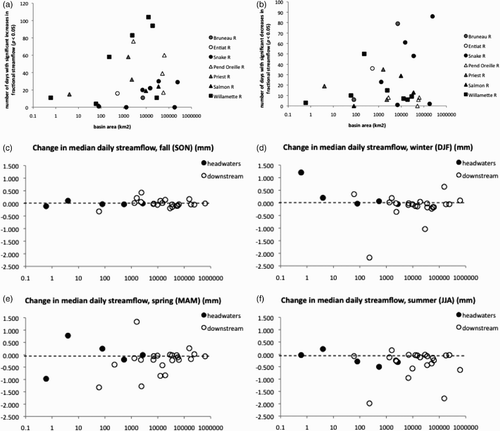
5 Discussion
Climate warming was associated with earlier spring peak flows in relatively undisturbed or partially logged headwaters of the Columbia River basin but not in headwaters that experienced wildfire or mining, and flow regulation downstream of dams appears to have overwhelmed the climate-warming signal from the headwaters over the period 1950 to 2010 ().
Fig. 13 Summary of changes observed in flows in seven principal sub-basins and mainstem of the Columbia River basin, 1950–2010. For each gauge, the circle symbol shows evidence of the expected climate signal from climate change (earlier spring peak, decreased late summer flow), and the square symbol shows evidence of the expected climate signal from flow regulation (reduced spring peak, increased late summer flow).
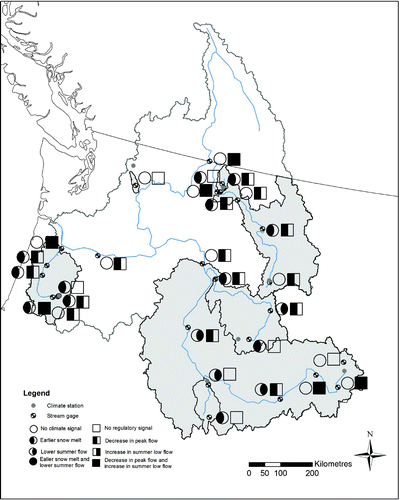
Large river basins integrate the signal of water from atmospheres to oceans. The tips of a large river basin network (the headwater streams) sense atmospheric inputs most directly, whereas downstream portions of the network integrate the atmospheric inputs as well as the influence of land use, water withdrawals, and flow regulation (dams). Therefore, headwater streamflow is expected to be more sensitive to climate change and variability than downstream flow (e.g., Jones et al., Citation2012). In the western United States climate warming is associated with earlier snowmelt, and in snowmelt-affected headwaters of large river basins climate warming is expected to produce a shift to earlier spring peak flows and reduced late summer flows. In contrast, downstream flows may sense the effects of flow regulation and land use more than climate warming (Cuo, Lettenmaier, Alberti, & Richey, Citation2009; Matheussen, Kirschbaum, Goodman, O'Donnell, & Lettenmaier, Citation2000; VanShaar, Haddeland, & Lettenmaier, Citation2002).
In a study of 68 unregulated streams in the Pacific Northwest from 1958 to 2008, Chang et al. (Citation2012) documented significant increases in the proportion of March streamflow to annual streamflow at stations above 1000 m elevation dominated by surface flow, but absolute March streamflow did not increase at most stations. In this study, however, climate warming was associated with earlier spring peak streamflow in only two of seven headwater basins; using medians, four of seven basins showed altered snowmelt runoff timing. These seven basins have long-term records of climate and streamflow, but they are not necessarily representative of the entire Columbia River basin. Spring streamflow shifted earlier in the headwaters of the Priest and Willamette, but not in the Bruneau (record only twelve years), Entiat (affected by wildfire), Pend Oreille (downstream of irrigated agriculture), Salmon (downstream of mining), or Snake (affected by wildfire) River basins. Although climate warming appears to have accelerated snowmelt runoff in relatively undisturbed headwater basins, disturbances have counteracted or obscured a climate signal on runoff in other headwater basins. Thus, ecological resilience (sensu Holling, Citation1996, i.e., persistence, variability, and unpredictability) has characterized headwater ecosystem responses to climate warming in the Columbia River basin.
By reducing snowpacks and accelerating snowmelt, climate warming may extend the summer drought period in western basins, leading to declines in late summer flows (Barnett et al., Citation2008; Hamlet et al., Citation2005; Hamlet & Lettenmaier, Citation2007; Lutz et al., Citation2012; Mote et al., Citation2003) and perhaps to increased variability of flow (Luce & Holden, Citation2009). Chang et al. (Citation2012) detected significant negative trends in September absolute streamflow in a majority of 68 gauges on unregulated streams in the Pacific Northwest from 1958 to 2008. However, in this study no reductions in late summer flow were detected in headwater basins, either in absolute or relative terms, despite the ability of this method to detect changes in very low flows. Moreover, streamflow variability (coefficient of variation of daily flow) increased only in the Salmon and Snake headwaters. In our study, September mean monthly flows declined at the Entiat, Snake, Salmon, and Willamette headwater basins, but we did not detect declining trends in daily flow in these basins, indicating that our method may be more conservative than methods that use mean monthly flows such as Chang et al. (Citation2012). On the other hand, unless they are corrected for precipitation, trends in monthly flows in September, at the end of the water year, may be affected by the timing of the arrival of the fall rains. Headwater ecosystems in the Columbia River basin are dominated by conifer forests which are adapted to summer drought and capable of reducing transpiration in response to elevated temperature. Our study found limited evidence of a climate-warming effect on late summer flows in headwater basins, indicating that streamflow from headwater ecosystems may have some ecological resilience to climate warming.
As expected, streamflow changed significantly over the period 1950 to 2010 throughout much of the year at gauges downstream of dams, reflecting management for engineering resilience to climate variability over the study period. The larger the basin, the more dams probably went into operation upstream over the period 1950 to 2010, and this resulted in a progressive increase from headwaters to downstream in numbers of days affected by river regulation. Moreover, the trends in streamflow observed downstream of dams were consistent with river regulation for flood control and low flow augmentation as shown by other studies (e.g., Graf, Citation2006). These expected changes included widespread reductions in flows during winter, spring, and early summer, when snowpacks melt and contribute to annual peak flows. Streamflow increased in late summer in the Snake River basin, and fractional flows increased in October in some downstream gauges in the Entiat, Pend Oreille, Snake, Priest, and Willamette basins. The latter four basins have a high density of dams along the mainstem that are operated for recreation and irrigation, and thus for supplementing late dry season low flows (). In addition, flow on the Columbia River mainstem at the United States–Canada border decreased from May to August and increased from September through April. Other studies have examined the effects of dams on streamflow in the Pacific Northwest (Dynesius & Nilsson, Citation1994; Graf, Citation1999, Citation2006; Moore, Arrigoni, & Wilcox, Citation2012) and considered how to mitigate modelled climate change effects on streamflow by altered reservoir operation (Hamlet & Lettenmaier, Citation1999; Lee, Hamlet, Fitzgerald, & Burges, Citation2009; Payne, Wood, Hamlet, Palmer, & Lettenmaier, Citation2004). The cumulative effect of increasing the number of dams on flood reduction during peak flow periods and flow augmentation during low flow periods was clearly expressed in these basins and overwhelmed the streamflow signal from headwaters indicating that flow regulation in these basins over the study period conferred engineering resilience to climate-warming effects on streamflow.
Because flow regulation for engineering resilience—flood peak reduction and supplementing late season low flows—may shift flow timing, even from one water year into another, flow regulation effects may be mistaken for climate-warming effects. For example, warning of an impending water supply crisis from climate change, Barnett et al. (Citation2008) cited the reduced variability of flow on the Columbia River, but this reduced flow variability is the clear result of the United States–Canada treaty on flow regulation (Treaty Relating to Cooperative Development of the Water Resources of the Columbia River Basin, Citation1961), which resulted in an abrupt decline in flow variability along the Columbia River mainstem in the 1970s.
Over the long term, climate change may increase streamflow variability in headwaters, but river regulation will continue to damp flow variability downstream. Which will dominate in the long term? Future trends in streamflow in the Columbia River basin will depend on ecological resilience, which is a measure of headwater ecosystem and streamflow response to climate warming and other disturbances, and engineering resilience, which depends on reservoir capacity, reservoir operation rule curves, and dam removal. If streamflow from headwater ecosystems displays ecological resilience to climate warming, the anticipated exacerbation of late summer hydrologic drought may not occur despite earlier snowmelt. At the same time, our study indicates that flow regulation in sub-basins of the Columbia River has provided considerable engineering resilience to climate warming. Although this engineered capacity may be reduced by future dam removal, it may also be increased by adjustment of dam operating rule curves. Thus, future streamflow responses to climate change in the Columbia River basin will be mitigated by both ecological and engineering resilience.
6 Conclusion
Ecological resilience (sensu Holling, Citation1996, i.e., persistence, variability, and unpredictability) has characterized headwater ecosystem responses to climate warming in the Columbia River basin, in the sense that spring snowmelt runoff timing was only slightly changed and no reductions in late summer flow were detected in headwater basins. In contrast, engineering resilience (efficiency, constancy, and predictability of flows) has characterized streamflow trends downstream of dams producing widespread reductions in flows during winter, spring, and early summer. Flow regulation also shifted the timing of flows, and these shifts may have been mistaken for climate change effects. Future streamflow response to climate change in the Columbia River basin will depend on ecological resilience, the net headwater streamflow response to climate warming and other disturbances and engineering resilience, a function of reservoir capacity, reservoir operation rule curves, and dam removal.
Acknowledgements
This paper is dedicated to the memory of Gail Achterman, whose deep understanding of water management and encouragement of big-picture scientific research inspired this work. This paper benefited from input from two anonymous referees. Support for this research was provided by National Science Foundation funding to the H.J. Andrews Long-term Ecological Research program (NSF 0823380), U.S. Geological Survey support of stream gauging, and ongoing U.S. Forest Service support to the H.J. Andrews, Entiat, and the Priest River Experimental Forests.
References
- Adams, M. B., Loughry, L., & Plaugher, L. (Comps.) (2008). Experimental Forests and Ranges of the USDA Forest Service (General Technical Report NE-321 Revised). Newtown Square, PA: U.S. Department of Agriculture, Forest Service, Northeastern Research Station.
- Barnett , T. P. , Pierce , D. W. , Hidalgo , H. G. , Bonfils , C. , Santer , B. D. , Das , T. , Bala , G. , Wood , A. W. , Nozawa , T. , Mirin , A. A. , Cayan , D. R. and Dettinger , M. D. 2008 . Human-induced changes in the hydrology of the western United States . Science , 319 : 1080 – 1083 . (doi:10.1126/science.1152538)
- Cayan , D. R. , Kammerdiener , S. A. , Dettinger , M. D. , Caprio , J. M. and Peterson , D. H. 2001 . Changes in the onset of spring in the western United States . Bulletin of the American Meteorological Society , 82 ( 3 ) : 399 – 415 . (doi:10.1175/1520-0477(2001)082<0399:CITOOS>2.3.CO;2)
- Chang , H. , Jung , I. W. , Steele , M. and Gannett , M. 2012 . Spatial patterns of March and September streamflow trends in Pacific Northwest streams, 1958–2008 . Geographical Analysis , 44 : 177 – 201 . (doi:10.1111/j.1538-4632.2012.00847.x)
- Christensen , N. L. , Agee , J. K. , Brussard , P. F. , Hughes , J. , Knight , D. H. , Minshall , G. W. , Peek , J. M. , Pyne , S. J. , Swanson , F. J. , Thomas , J. W. , Wells , S. , Williams , S. E. and Wright , H. A. 1989 . Interpreting the Yellowstone fires of 1988: Ecosystem responses and management implications . BioScience , 39 : 678 – 722 . (doi:10.2307/1310998)
- Cuo , L. , Lettenmaier , D. P. , Alberti , M. and Richey , J. 2009 . Effects of a century of land cover and climate change on the hydrology of the Puget Sound basin . Hydrological Processes , 23 : 907 – 933 . (doi:10.1002/hyp.7228)
- Dynesius , M. and Nilsson , C. 1994 . Fragmentation and flow regulation of river systems in the northern third of the world . Science , 266 : 753 – 762 . (doi:10.1126/science.266.5186.753)
- Folke , C. 2003 . Freshwater for resilience: A shift in thinking . Philosophical Transactions of the Royal Society London, series B , 358 : 2027 – 2036 . doi:10.1098/rstb.2003.1385 (doi:10.1098/rstb.2003.1385)
- Graf , W. L. 1999 . Dam nation: A geographic census of American dams and their large-scale hydrologic impacts . Water Resources Research , 35 : 1305 – 1311 . (doi:10.1029/1999WR900016)
- Graf , W. L. 2006 . Downstream hydrologic and geomorphic effects of large dams on American rivers . Geomorphology , 79 : 336 – 360 . (doi:10.1016/j.geomorph.2006.06.022)
- Hamlet , A. F. and Lettenmaier , D. P. 1999 . Effects of climate change on hydrology and water resources objectives in the Columbia River basin . Journal of the American Water Resources Association , 35 : 1597 – 1624 . (doi:10.1111/j.1752-1688.1999.tb04240.x)
- Hamlet , A. F. and Lettenmaier , D. P. 2007 . Effects of 20th century warming and climate variability on flood risk in the western U.S . Water Resources Research , 43 : W06427 doi:10.1029/2006WR005099 (doi:10.1029/2006WR005099)
- Hamlet , A. F. , Mote , P. W. , Clark , M. P. and Lettenmaier , D. P. 2005 . Effects of temperature and precipitation variability on snowpack trends in the western United States . Journal of Climate , 18 : 4545 – 4561 . (doi:10.1175/JCLI3538.1)
- Hatcher, K. L. (2011). Interacting effects of climate, forest dynamics, landforms, and river regulation on streamflow trends since 1950: Examples from the Willamette Basin and forested headwater sites in the US. Oregon State University, Corvallis, Oregon. Retrieved from http://ir.library.oregonstate.edu/xmlui/handle/1957/88
- Helsel , D. R. and Hirsch , R. M. 1992 . Statistical methods in water resources , Edited by: Helsel , D. R. and Hirsch , R. M. New York : Elsevier .
- Helsel, D. R., Mueller, D. K., & Slack, J. R. (2005). Computer program for the Kendall family of trend tests (Scientific Investigations Report 2005-5275). Retrieved from http://pubs.usgs.gov/sir/2005/5275/pdf/sir2005-5275.pdf
- Hicks , B. J. , Beschta , R. L. and Harr , R. D. 1991 . Long-term changes in streamflow following logging in western Oregon and associated fisheries implications . Water Resources Bulletin , 27 : 217 – 226 . (doi:10.1111/j.1752-1688.1991.tb03126.x)
- Holling , C. S. 1973 . Resilience and stability of ecological systems . Annual Review of Ecology and Systematics , 4 : 1 – 23 . (doi:10.1146/annurev.es.04.110173.000245)
- Holling , C. S. 1996 . “ Engineering resilience versus ecological resilience ” . In Engineering within ecological constraints , Edited by: Schulze , P. C. 31 – 43 . Washington , DC : National Academy Press .
- Hovmöller , E. 1949 . The trough-and-ridge diagram . Tellus , 1 : 62 – 66 . (doi:10.1111/j.2153-3490.1949.tb01260.x)
- Jones , J. A. , Creed , I. F. , Hatcher , K. L. , Warren , R. J. , Adams , M. B. , Benson , M. H. , Boose , E. , Brown , W. A. , Campbell , J. L. , Covich , A. , Clow , D. W. , Dahm , C. N. , Elder , K. , Ford , C. R. , Grimm , N. B. , Henshaw , D. L. , Larson , K. L. , Miles , E. S. , Miles , K. M. , Sebestyen , S. D. , Spargo , A. T. , Stone , A. B. , Vose , J. M. and Williams , M. W. 2012 . Ecosystem processes and human influences regulate streamflow response to climate change at long-term ecological research sites . BioScience , 62 ( 4 ) : 390 – 404 . (doi:10.1525/bio.2012.62.4.10)
- Jones , J. A. and Grant , G. E. 1996 . Peak flow response to clearcutting and roads in small and large basins, western Cascades, Oregon . Water Resources Research , 32 : 959 – 974 . (doi:10.1029/95WR03493)
- Jones , J. A. and Grant , G. E. 2001 . Comment on “Peak flow responses to clear-cutting and roads in small and large basins, western Cascades, Oregon: A second opinion” by R. Thomas and W. Megahan [paper 98WR02500. Water Resources Research, 34 (12), December 1998] . Water Resources Research , 37 : 175 – 178 . (doi:10.1029/2000WR900276)
- Jones , J. A. and Post , D. A. 2004 . Seasonal and successional streamflow response to forest cutting and regrowth in the northwest and eastern United States . Water Resources Research , 40 : W05203 doi:10.1029/2003WR002952 (doi:10.1029/2003WR002952)
- Karl , T. R. , Melillo , J. M. and Peterson , T. C. 2009 . Global climate change impacts in the United States: A state of knowledge report from the U.S. Global Change Research Program , Edited by: Karl , T. R. , Melillo , J. M. and Peterson , T. C. New York : Cambridge University Press .
- Knowles , N. , Dettinger , M. D. and Cayan , D. R. 2006 . Trends in snowfall versus rainfall in the western United States . Journal of Climate , 19 : 4545 – 4559 . (doi:10.1175/JCLI3850.1)
- Lee , S. Y. , Hamlet , A. F. , Fitzgerald , C. J. and Burges , S. J. 2009 . Optimized flood control in the Columbia River basin for a global warming scenario . Journal of Water Resources Planning and Management , 135 : 440 – 450 . (doi:10.1061/(ASCE)0733-9496(2009)135:6(440))
- Littell, J. S., Elsner, M. M., Mauger, G. S., Lutz, E., Hamlet, A. F., & Salathé, E. (2011). Regional climate and hydrologic change in the northern US Rockies and Pacific Northwest: Internally consistent projections of future climate for resource management (Project report: April 17, 2011). Retrieved from the Center for Science in the Earth System website: http://cses.washington.edu/picea/USFS/pub/Littell_etal_2010/
- Luce , C. H. and Holden , Z. A. 2009 . Declining annual streamflow distributions in the Pacific Northwest United States, 1948–2006 . Geophysical Research Letters , 36 : L16401 doi:10.1029/2009GL039407 (doi:10.1029/2009GL039407)
- Lutz , E. R. , Hamlet , A. F. and Littell , J. S. 2012 . Paleoreconstruction of cool season precipitation and warm season streamflow in the Pacific Northwest with applications to climate change assessments . Water Resources Research , 48 : W01525 doi:10.1029/2011WR010687 (doi:10.1029/2011WR010687)
- Matheussen , B. , Kirschbaum , R. L. , Goodman , I. A. , O'Donnell , G. M. and Lettenmaier , D. P. 2000 . Effects of land cover change on streamflow in the interior Columbia River Basin: USA and Canada . Hydrological Processes , 14 : 867 – 885 . (doi:10.1002/(SICI)1099-1085(20000415)14:5<867::AID-HYP975>3.0.CO;2-5)
- Moore , J. N. , Arrigoni , A. S. and Wilcox , A. C. 2012 . Impacts of dams on flow regimes in three headwater subbasins of the Columbia River basin, United States . Journal of the American Water Resources Association , 48 : 925 – 938 . doi:10.1111/j.1752-1688.2012.00660.x (doi:10.1111/j.1752-1688.2012.00660.x)
- Mote , P. W. 2003 . Trends in snow water equivalent in the Pacific Northwest and their climatic causes . Geophysical Research Letters , 30 : 1601 – 1604 . doi:10.1029/2003GL017258 (doi:10.1029/2003GL017258)
- Mote , P. W. , Parson , E. A. , Hamlet , A. F. , Keeton , W. S. , Lettenmaier , D. , Mantua , N. , Miles , E. L. , Peterson , D. W. , Peterson , D. L. , Slaughter , R. and Snover , A. 2003 . Preparing for climatic change: The water, salmon, and forests of the Pacific Northwest . Climatic Change , 61 : 45 – 88 . (doi:10.1023/A:1026302914358)
- Mote , P. W. and Salathé , E. P. 2010 . Future climate in the Pacific Northwest . Climatic Change , 102 : 29 – 50 . doi:10.1007/s10584-010-9848-z (doi:10.1007/s10584-010-9848-z)
- Naik , P. and Jay , D. A. 2005 . Estimation of Columbia River virgin flow: 1879 to 1928 . Hydrological Processes , 19 : 1807 – 1824 . (doi:10.1002/hyp.5636)
- Nayak , A. , Marks , D. , Chandler , D. G. and Seyfried , M. 2010 . Long-term snow, climate, and streamflow trends at the Reynolds Creek Experimental Watershed, Owyhee Mountains, Idaho, United States . Water Resources Research , 46 : W06519 doi:10.1029/2008WR007525 (doi:10.1029/2008WR007525)
- Payne , J. T. , Wood , A. W. , Hamlet , A. F. , Palmer , R. N. and Lettenmaier , D. P. 2004 . Mitigating the effects of climate change on the water resources of the Columbia River Basin . Climatic Change , 62 ( 1–3 ) : 233 – 256 . (doi:10.1023/B:CLIM.0000013694.18154.d6)
- Perry, T. D. (2007). Do vigorous young forests reduce streamflow? Results from up to 54 years of streamflow records in eight paired-watershed experiments in the H. J. Andrews and South Umpqua Experimental Forests. (Unpublished master's thesis). Oregon State University, Corvallis, Oregon. Retrieved from http://ir.library.oregonstate.edu/xmlui/handle/1957/88
- Ramsay , F. L. and Schaefer , D. W. 1996 . The statistical sleuth: A course in methods of data analysis , Belmont , CA : Duxbury Press .
- Stewart , I. T. , Cayan , D. R. and Dettinger , M. D. 2005 . Changes toward earlier streamflow timing across western North America . Journal of Climate , 18 : 1136 – 1155 . (doi:10.1175/JCLI3321.1)
- Thomas , R. B. and Megahan , W. F. 1998 . Peak flow responses to clear-cutting and roads in small and large basins, western Cascades, Oregon: A second opinion . Water Resources Research , 34 : 3393 – 3403 . (doi:10.1029/98WR02500)
- Thomas , R. B. and Megahan , W. F. 2001 . Reply to Comment on Peak flow responses to clear-cutting and roads in small and large basins, western Cascades, Oregon: A second opinion by R. Thomas and W. Megahan [paper 98WR02500. Water Resources Research, 34(12), December 1998] . Water Resources Research , 37 : 181 – 183 . (doi:10.1029/2000WR900277)
- Treaty Relating to Cooperative Development of the Water Resources of the Columbia River Basin, United States of America–Canada, January 17, 1961, 15 U.S.T. 1555.
- Turner , M. B. , Romme , W. H. , Gardner , R. H. and Hargrove , W. W. 1997 . Effects of fire size and pattern on early succession in Yellowstone National Park . Ecological Monographs , 67 : 411 – 433 . (doi:10.1890/0012-9615(1997)067[0411:EOFSAP]2.0.CO;2)
- US Department of the Interior. (2012). National Atlas Data Download [Data]. Retrieved from http://www.nationalatlas.gov/atlasftp.html#dams00x
- USGS (United States Geological Survey). (2012a). 1:250,000-scale Hydrologic Units of the United States [Data]. Retrieved from http://water.usgs.gov/GIS/metadata/usgswrd/XML/huc250k.xml
- USGS (United States Geological Survey). (2012b). National Land Cover Database 2006 (NLCD2006) [Data]. Retrieved from the Multi-Resolution Land Characteristics Consortium (MRLC) website: http://www.mrlc.gov/nlcd06_data.php
- USGS (United States Geological Survey). (2012c). Global 30 Arc-Second Elevation (GTOPO30) [Data]. Retrieved from the Earth Resources Observation and Science (EROS) Center website: http://eros.usgs.gov/#/Find_Data/Products_and_Data_Available/GTOPO30
- VanShaar , J. R. , Haddeland , I. and Lettenmaier , D. P. 2002 . Effects of land-cover changes on the hydrological response of interior Columbia River basin forested catchments . Hydrological Processes , 16 : 2499 – 2520 . (doi:10.1002/hyp.1017)
- Woodsmith, R. D., Vache, K. B., McDonnell, J. J., Seibert, J., & Helvey, J. D. (2007). The Entiat Experimental Forest: A unique opportunity to examine hydrologic response to wildfire. In M. Furniss, C. Clifton, & K. Ronnenberg (Eds.), Advancing the fundamental sciences: Proceedings of the Forest Service National Earth Sciences Conference, San Diego, CA, 18–22 October 2004 (pp. 205–216) (PNW-GTR 689). Portland, OR: U.S. Department of Agriculture, Forest Service, Pacific Northwest Research Station.
